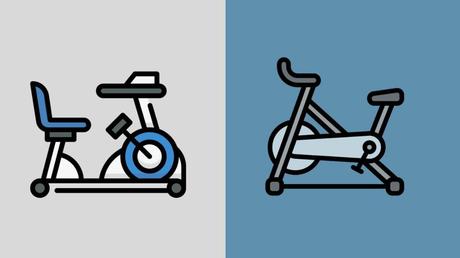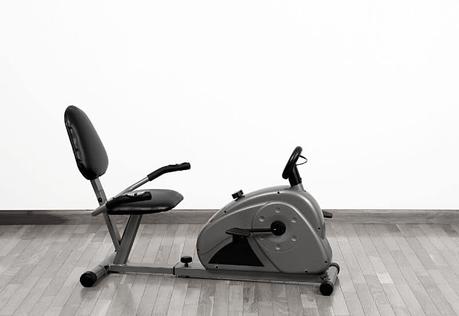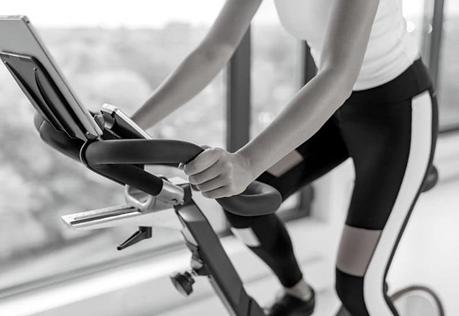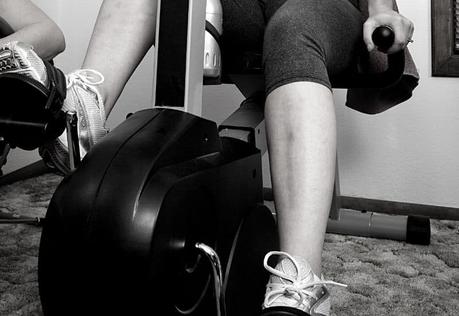Wondering if a recumbent bike or upright stationary bike is better for your workout goals? Join us as we compare the pros and cons of both to help you determine which is best for your fitness goals.
 In this comparison:
In this comparison:- Recumbent Bike vs. Upright Bike
- Calories Burned
- Muscles Worked
- Functional Fitness
- Impact & Injuries
- Cost & Footprint
- FAQs
- Is an upright stationary bike harder than a recumbent bike?
- Is the recumbent bike or stationary bike easier on the knees?
- Recumbent Bike vs. Upright Bike – Final Verdict
Exercise bikes are one of the best cardio machines at your local gym.
They are low-impact, offer varying degrees of resistance, and feature tons of different training programs.
Among the different types of stationary bikes are the recumbent bike and the “classic” stationary bike, and in this post, we will compare them.
We will look at: Calories burned, muscle groups worked, impact, footprint, cost, and much more.
By the end, you will be able to confidently choose the right stationary bike for pedaling toward your fitness goals.
Recumbent Bike vs. Upright Bike
Ding-ding! Let’s get it on!
Calories Burned
When it comes to losing weight, it’s all about the calorie-burning. As long as you’re burning more calories per day than you’re consuming, your body is forced to tap into stored fats to fuel itself throughout the day.
More calories burned = a better chance of weight loss.
Pretty straightforward, right? What this means is that the cardio machine that burns the most calories for the time you spend training will be the “best” in this specific area.
Harvard Medical School1 collected data on how effectively various types of exercise and cardio machines burned calories in order to “rank” them.
According to their data:
- A 125-pound person can burn around 210 calories in 30 minutes of “moderate” exercise on a stationary bike.
- A 155-pound person can burn around 252 calories in 30 minutes of “moderate” exercise on a stationary bike.
- A 185-pound person can burn around 294 calories in 30 minutes of “moderate” exercise on a stationary bike.
Not too bad, right? The results get even better when you push the pace—based on the same data:
- A 125-pound person can burn around 315 calories in 30 minutes of “vigorous” exercise on a stationary bike.
- A 155-pound person can burn around 378 calories in 30 minutes of “vigorous” exercise on a stationary bike.
- A 185-pound person can burn around 441 calories in 30 minutes of “vigorous” exercise on a stationary bike.
Now those are some results you can love!
It’s important to know that this data applies to the upright bike, which is why it’s considered one of the top cardio machines for burning calories.
So how does the recumbent bike stack up? Does the fact that you’re sitting in a more relaxed position and pedaling forward/backward instead of up/down change anything?

One study compared various types of cardio machines (including recumbent bikes and upright bikes) and found that lower body muscle activation (glutes, quads, and hamstrings) “were similar across all devices.”
This is great for your muscles worked (as you’ll see in the next section), but it doesn’t say much for calories.
Another study compared various metrics (such as heart rate, blood pressure, rating of perceived exertion, and oxygen uptake, among others) and found that upright cycling was more challenging to the body than recumbent cycling.
Though the difference was fractional, of the two machines, the upright bike is the best cardio machine for losing weight when choosing between the recumbent or upright bike as it pushes your body harder—and in so doing, burns at least a few more calories than the recumbent bike.
Muscles Worked
With both types of exercise bikes, the lower body muscles worked remain the same:
- Your quadriceps muscles do much of the work of driving the pedal downward, especially when pedaling from a seated position.
- Your hamstrings and glutes provide support and serve as the antagonist muscles to power up the legs when the quads are relaxing.
- Your calf muscles engage to maintain your foot position on the pedal while you’re working.
For lower body muscle activation, both types of bikes are equally effective.
Where it changes, though, is in the core and upper body muscle activation.
When sitting on an upright bike and leaning forward to grab the handles, your arms, shoulders, chest, forearms, and upper back muscles engage fractionally to support your upper body. Your abs also provide power for your legs to drive downward, and your lower back works to maintain your posture while cycling.

By contrast, with the recumbent bike, you’re sitting in a seat that provides total support for your upper body and drastically reduces core engagement. The focus is almost exclusively on your legs, with only a little bit of ab work to keep your legs driving forward.
While this is great for anyone who is recovering from upper body or lower back injuries (isolating the work to the legs), it’s less-than-ideal for anyone in prime shape who works out to improve their overall fitness.
You’ll see less upper body and core muscle activation—and thereby, growth—on the recumbent bike than the upright bike.
Functional Fitness
The term “functional fitness” refers to fitness as it pertains to your activities of daily life. For example, your ability to take your pets on a hike, run and play with your kids, haul heavy loads of shopping into the house, lift heavy boxes in your garage or attic, and so on.
Some exercises are excellent for improving functional fitness because they mirror the sort of activities that are part of your daily life. Walking, jogging, and running are the most “functional” forms of exercise for this reason.
The stationary bike is functional for anyone who regularly goes cycling. The exercise you’ll do on the stationary bike will translate into more effective pedaling, hill cycling, and long-distance riding on the streets, mountain trails, or roads around your city.

Between the recumbent and upright bike, it’s pretty easy to see which is the more functional of the two: the one that mirrors “real life” most accurately.
The time you spend training on the upright bike will be most akin to the work you do on your regular bike. When the time comes to hop on your road or mountain bike and hit the great outdoors, you’ll have trained in a more “real” form thanks to all those hours you’ve put in on the upright bike.
Impact & Injuries
One of the best benefits of stationary bikes is the fact that they provide a low-impact workout that is very joint- and muscle-friendly.
When you lift your feet off the ground (as you do when you walk, run, or jump), there is a certain amount of impact, or vibrations that travel up your skeletal structure, when your weight comes back down.
The higher your weight lifts off the ground (i.e. jumping), the higher the impact. By contrast, the less weight is lifted off the ground, the lower the impact.
On all types of stationary bikes, your feet remain firmly planted on the pedals, so there is virtually no impact. Both the recumbent and upright bikes are equally joint-friendly for this very reason.
However, the injury risk between the two isn’t quite the same, and it’s not because of the impact.

When on the recumbent bike, your upper body is totally supported, and your legs end up doing the vast majority of the work. There is some slight risk to your knees (knee injuries are the most common injuries for cyclists), but you’re largely “safe” from injuries because of the recumbent design.
By contrast, the upright bike is going to be slightly more likely to cause you injuries. Your knees are at risk (same as on the recumbent bike), but your lower back will also be at risk (unlike the recumbent bike).
When you drive your foot downward, the lower back muscles engage along with your lower body to facilitate the movement. Your core provides stability and braces so your legs can push downward.
Over time, the repeated downward pushing can tire out your lower back. Add to that a slightly forward-leaning posture (including a hunch for those who have poor upper body posture), and there is more strain placed on your lower back than you realize.
In my experience, I’ve found I’m more likely to strain or injure my lower back on the upright bike than even more back-focused machines (such as the rowing machine). This higher injury risk is simply due to the way your body moves and braces while pedaling upward/downward from the specific sitting position.
Cost & Footprint
Last, but definitely not least, we’ve got to assess how both of these machines will affect your wallet and your home gym setup.
Upright bikes are some of the cheapest exercise machines—you can find “budget” models in the $150 to $300 range, and mid-tier models around $400 to $800. When you really get to the high end, you’re looking at anywhere from $750 to $2,000 for a really top-quality stationary bike (like the Peloton) that packs all the high-end features you want.
Recumbent bikes tend to be slightly more expensive on the lower-end. You can find a “budget” recumbent bike starting at around $200 to $400, and the mid-tier models will run you upwards of $600. However, you won’t find any really high-end recumbent bike models.
Plot Twist: There are some stationary bikes that can be converted between upright and recumbent positions. Two machines in one!
The “footprint” of the bike refers to how much floor space it takes up. One look at the two machines, and you’ll see instantly which has a larger footprint.
Upright bikes are built to resemble regular bikes, with a large front wheel (housing the magnetic flywheel) and a smaller frame with the elevated seat. They will actually take up less space in your house than a real bike because there is no rear wheel.
On the other hand, recumbent bikes feature the same front wheel, but the frame is longer because of the recumbent seat. The seat stretches back far enough that you can extend your legs fully to pedal forward/backward.
Ultimately, a recumbent bike will take up more space in your gym than a real bike—and far more than an upright bike.
FAQs
Is an upright stationary bike harder than a recumbent bike?
Yes, and it’s due to the design and biomechanics of the human body.
On the recumbent bike, you’ve got a comfortable seat to provide support, and you’re in a position that is easier on your body (very much a good thing!). The pedaling motion is also largely horizontal, which means there is a limitation on the amount of power the legs can apply to the pedals.
Trainees tend to pedal harder on the upright bike because more power can be exerted. With the legs pointing mostly downwards and the hips in an elevated position, the upright bike recruits the hips in its most optimal position to deliver force. The hips, after all, are where a majority of lower body power is derived from.
So while an upright bike is “harder,” it’s only because you can generate more force thanks to better body mechanics and a slight helping hand from gravity.
Is the recumbent bike or stationary bike easier on the knees?
One of the key benefits of both these bikes is that they are low-impact, unlike your friendly neighborhood treadmill.
If you have sore or bad knees, the recumbent bike can almost completely take the impact away. The reduced power demand of the recumbent is also great for gentle exercising.
One tip I always give clients, whether an athlete is coming off a knee injury or someone getting started on their fitness journey, is to avoid excessive knee bend on both the recumbent and upright bike.
This means that the bottom of the pedaling motion should yield a leg that is nearly straight, and your knees should not be breaking 90-degrees at the top phase of the pedaling.
Recumbent Bike vs. Upright Bike – Final Verdict
The recumbent bike is the perfect machine for anyone who:
- Wants a low-impact, low-risk machine
- Needs a cardio machine to use while rehabbing upper body injuries
- Prefers a workout with minimal discomfort on the joints
- Hate the shape of the upright bike seat and wants to be more comfortable while working out
The upright bike is the right choice for anyone who:
- Wants to save on costs and occupy less space in their home gym
- Prefers a higher-intensity, higher-effort workout
- Likes challenging themselves with more advanced training sessions
- Wants to work more muscles, burn more calories, and improve their upper body posture
The Bottom Line
Both the upright bike and recumbent bike have plenty to offer.
One is ideal for rehab and a lower-effort workout (ideal for senior citizens), while the other delivers a higher intensity, more functional, more challenging training session.
Picking between a recumbent or upright bike ultimately comes down to your personal preferences, fitness goals, and in the case of building out a home gym, cost and footprint.
Choose the right option for you and get pedaling towards improved health and fitness!
